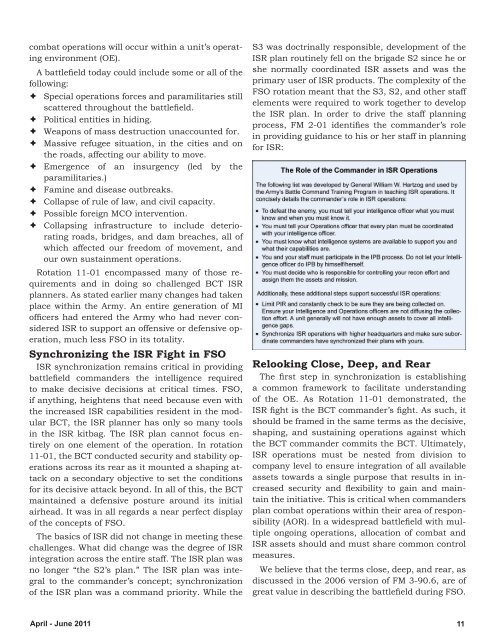George w. casey jr. - Federation of American Scientists
George w. casey jr. - Federation of American Scientists
George w. casey jr. - Federation of American Scientists
You also want an ePaper? Increase the reach of your titles
YUMPU automatically turns print PDFs into web optimized ePapers that Google loves.
combat operations will occur within a unit’s operating<br />
environment (OE).<br />
A battlefield today could include some or all <strong>of</strong> the<br />
following:<br />
Special operations forces and paramilitaries still<br />
scattered throughout the battlefield.<br />
Political entities in hiding.<br />
Weapons <strong>of</strong> mass destruction unaccounted for.<br />
Massive refugee situation, in the cities and on<br />
the roads, affecting our ability to move.<br />
Emergence <strong>of</strong> an insurgency (led by the<br />
paramilitaries.)<br />
Famine and disease outbreaks.<br />
Collapse <strong>of</strong> rule <strong>of</strong> law, and civil capacity.<br />
Possible foreign MCO intervention.<br />
Collapsing infrastructure to include deteriorating<br />
roads, bridges, and dam breaches, all <strong>of</strong><br />
which affected our freedom <strong>of</strong> movement, and<br />
our own sustainment operations.<br />
Rotation 11-01 encompassed many <strong>of</strong> those requirements<br />
and in doing so challenged BCT ISR<br />
planners. As stated earlier many changes had taken<br />
place within the Army. An entire generation <strong>of</strong> MI<br />
<strong>of</strong>ficers had entered the Army who had never considered<br />
ISR to support an <strong>of</strong>fensive or defensive operation,<br />
much less FSO in its totality.<br />
Synchronizing the ISR Fight in FSO<br />
ISR synchronization remains critical in providing<br />
battlefield commanders the intelligence required<br />
to make decisive decisions at critical times. FSO,<br />
if anything, heightens that need because even with<br />
the increased ISR capabilities resident in the modular<br />
BCT, the ISR planner has only so many tools<br />
in the ISR kitbag. The ISR plan cannot focus entirely<br />
on one element <strong>of</strong> the operation. In rotation<br />
11-01, the BCT conducted security and stability operations<br />
across its rear as it mounted a shaping attack<br />
on a secondary objective to set the conditions<br />
for its decisive attack beyond. In all <strong>of</strong> this, the BCT<br />
maintained a defensive posture around its initial<br />
airhead. It was in all regards a near perfect display<br />
<strong>of</strong> the concepts <strong>of</strong> FSO.<br />
The basics <strong>of</strong> ISR did not change in meeting these<br />
challenges. What did change was the degree <strong>of</strong> ISR<br />
integration across the entire staff. The ISR plan was<br />
no longer “the S2’s plan.” The ISR plan was integral<br />
to the commander’s concept; synchronization<br />
<strong>of</strong> the ISR plan was a command priority. While the<br />
S3 was doctrinally responsible, development <strong>of</strong> the<br />
ISR plan routinely fell on the brigade S2 since he or<br />
she normally coordinated ISR assets and was the<br />
primary user <strong>of</strong> ISR products. The complexity <strong>of</strong> the<br />
FSO rotation meant that the S3, S2, and other staff<br />
elements were required to work together to develop<br />
the ISR plan. In order to drive the staff planning<br />
process, FM 2-01 identifies the commander’s role<br />
in providing guidance to his or her staff in planning<br />
for ISR:<br />
Relooking Close, Deep, and Rear<br />
The first step in synchronization is establishing<br />
a common framework to facilitate understanding<br />
<strong>of</strong> the OE. As Rotation 11-01 demonstrated, the<br />
ISR fight is the BCT commander’s fight. As such, it<br />
should be framed in the same terms as the decisive,<br />
shaping, and sustaining operations against which<br />
the BCT commander commits the BCT. Ultimately,<br />
ISR operations must be nested from division to<br />
company level to ensure integration <strong>of</strong> all available<br />
assets towards a single purpose that results in increased<br />
security and flexibility to gain and maintain<br />
the initiative. This is critical when commanders<br />
plan combat operations within their area <strong>of</strong> responsibility<br />
(AOR). In a widespread battlefield with multiple<br />
ongoing operations, allocation <strong>of</strong> combat and<br />
ISR assets should and must share common control<br />
measures.<br />
We believe that the terms close, deep, and rear, as<br />
discussed in the 2006 version <strong>of</strong> FM 3-90.6, are <strong>of</strong><br />
great value in describing the battlefield during FSO.<br />
April - June 2011 11















